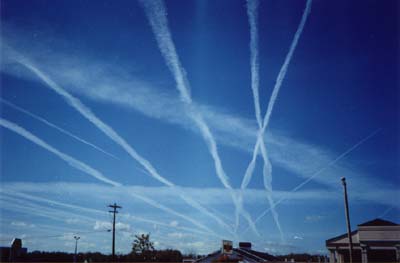Digging Deeper: Global Dimming
Human activities from agriculture to industry release particulates into the air. Studies in many parts of the world indicate that insolation has been decreasing as particulate concentrations have been increasing, a phenomenon called global dimming. Research conducted in the Maldives demonstrated that dirty air descending from India produced a three kilometers thick pollutant layer that hung over the northern islands. The pollutant layer cut down the sunlight reaching the ocean by more than 10 percent. Climate scientists fear that the reduction of insolation by atmospheric particulates are masking the true magnitude of global warming. A reduction of particulate pollution to protect human health may cause an increase in insolation and thus accelerate global warming.
 Figure
4.* Contrails from passenger jets are thought to impact the daily
range of temperature. Courtesy NWS NOAA (Source)
Figure
4.* Contrails from passenger jets are thought to impact the daily
range of temperature. Courtesy NWS NOAA (Source)
Contrails are clouds produced from jet exhaust and have been a subject of research for some time. They are difficult to study because they develop and dissipate quite rapidly, or so many of them in the sky they merge. This makes it difficult to perform baseline studies on individual clouds. When first formed they are thick and rounded blocking light like low stratus clouds causing the air to cool. Over time they morph into thinner clouds like high cirrus better at absorbing radiation thus warming the air. When air transportation was suspended over the United States shortly after the events of September 11, 2001, atmospheric scientists had an opportunity to study the effect of contrails on weather. What they found was daily temperature ranges increased by as much a two degrees fahrenheit in the absence of contrails over the contiguous United States.
Video: Climate Change and Global Dimming
Courtesy The MetOffice
Jim Haywood, climate expert at the Met Office Hadley Centre,
explains the phenomenon of global dimming and the impacts on global warming.
